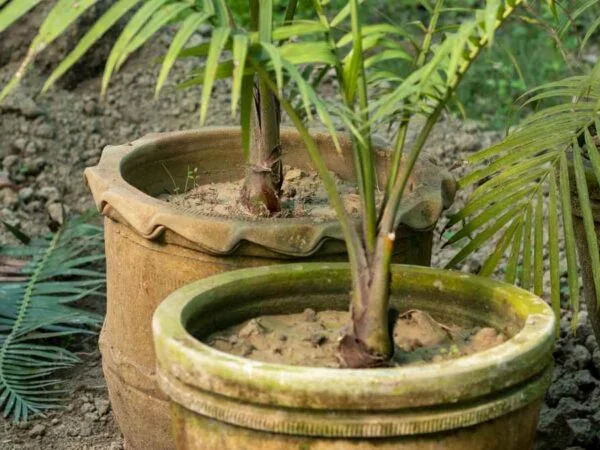Areca palm height is a common concern among houseplant enthusiasts, and I'm here to provide you with accurate information to address your queries effectively. With my plant experience and tips, you can rest assured that you'll gain valuable insights into the height of Areca palms and how to manage their growth successfully.
The Areca palm, scientifically known as Dypsis lutescens, typically reaches heights ranging from 6 to 12 feet indoors and up to 30 feet in its natural habitat. These elegant palms are popular for their graceful appearance and ability to thrive in various conditions. When cultivated indoors, they require proper care, including adequate sunlight, regular watering, and occasional fertilization, to maintain their optimal height and health. Understanding these factors is crucial for ensuring the successful growth of Areca palms in your home or garden.
If you're intrigued by the fascinating world of indoor gardening, I have a wealth of knowledge to share about selecting the right plants, optimizing growing conditions, and troubleshooting common issues. Feel free to explore further for expert advice and tips on nurturing a thriving green space indoors.
Key Takeaways
- Provide Adequate Light: Place your Areca Palm in bright, indirect light to promote healthy growth and height.
- Maintain Well-Draining Soil: Ensure the soil is well-draining and rich in nutrients for optimal growth.
- Water Wisely: Water the plant thoroughly but allow the topsoil to dry out slightly between watering sessions.
- Control Temperature and Humidity: Keep your Areca Palm in a warm and humid environment to support its growth.
- Feed Regularly: Fertilize your Areca Palm regularly with a balanced fertilizer to encourage vertical growth.
- Prune Strategically: Trim back any dead or yellowing fronds to direct energy towards vertical growth.
Optimal Light Conditions
Light Requirements
Areca palms thrive in bright, filtered sunlight to support their growth and development. Avoid direct sunlight exposure as it can lead to leaf burn, impacting the plant's health negatively. Consistent light exposure is essential for maintaining the plant's well-being.
Sunlight Intensity
To ensure the optimal growth of your areca palm, provide moderate to bright sunlight. Avoid placing the plant in areas with intense, direct sunlight, which can be harmful. Monitoring sunlight intensity regularly is crucial to prevent any potential scorching of the leaves.
Placement Tips
When choosing a spot for your areca palm, opt for an area with bright, filtered sunlight to promote healthy growth. It's important to keep the plant away from cold drafts and heat sources indoors. Proper placement plays a significant role in ensuring the overall health and vitality of your areca palm.
Soil Quality and Composition
Ideal Soil Mix
To ensure optimal growth of areca palm, use well-draining soil or a specialized palm potting mix. This type of soil helps prevent waterlogging, promoting healthy root development. Good aeration in the soil is crucial for the roots to thrive. Select a soil mix that can retain moisture without becoming excessively wet.
Drainage Importance
Proper drainage is essential to avoid waterlogging, which can harm areca palms. Opt for pots with drainage holes to allow excess water to escape easily. Poor drainage can lead to root rot and other detrimental issues that may affect the plant's overall health.
Watering Areca Palm
Water Frequency
- Water the areca palm when the soil starts to dry out.
- Avoid overwatering to prevent root rot.
- Maintain a consistent watering schedule for best results.
Moisture Levels
- Keep the soil consistently moist but not waterlogged.
- Monitor soil moisture levels regularly.
- Adjust watering frequency based on the plant's needs.
Temperature and Humidity Control
Ideal Temperature
Maintain average temperatures of 70 to 80 degrees F for optimal growth. Protect the plant from extreme temperature fluctuations. Avoid exposing the plant to temperatures below 50 degrees F.
Humidity Needs
Provide high humidity levels for the areca palm. Mist the plant regularly to increase humidity. Consider using a humidifier to maintain ideal humidity levels.
Fertilizing for Growth
Fertilizer Types
Choose a balanced fertilizer specifically designed for palms to ensure optimal growth. Opt for slow-release fertilizers as they provide a steady supply of nutrients over time. Avoid overfertilizing to prevent nutrient imbalances that can harm the plant.
Application Schedule
During the spring and summer, regularly fertilize the areca palm to support its growth. Follow the recommended application schedule provided on the fertilizer package for best results. Adjust the frequency of fertilization based on how quickly the plant is growing.
Pruning for Height
Pruning Techniques
Prune yellowing or damaged fronds using clean, sharp tools to maintain plant health. Avoid excessive pruning to prevent stress on the areca palm.
- Trim yellowing or damaged fronds
- Use clean, sharp tools for pruning
- Prune sparingly to avoid stressing the plant
Timing Pruning
Prune the areca palm as needed throughout the year. Remove dead or yellowing fronds promptly to maintain plant health.
- Prune as needed throughout the year
- Remove dead or yellowing fronds promptly
- Avoid excessive pruning to maintain natural appearance
Repotting Essentials
Repotting Frequency
Repot houseplants every 2-3 years to refresh soil and allow for better growth conditions. Opt for a slightly larger pot to accommodate the expanding roots. This practice helps prevent root-bound issues and encourages robust plant development.
Choosing Pots
When selecting pots for your areca palm, prioritize those with drainage holes to avoid water stagnation, which can harm the plant. Ensure the chosen pot offers sufficient space for the roots to grow freely. Consider the size of the plant when deciding on the pot's dimensions.
Propagation Methods
Division Technique
Dividing areca palms is a common method to propagate new plants. Carefully divide the plant to ensure each part has enough roots for growth. Utilize a sharp, clean tool to avoid damaging the plant during division.
- Use a sharp, clean tool
- Ensure sufficient roots for growth
- Divide the plant carefully
Seed Propagation
Seed propagation involves collecting seeds from mature areca palms. Plant these seeds in a well-draining soil mix to facilitate germination. Keep a close eye on the seedlings to monitor their growth progress.
- Collect seeds from mature palms
- Plant in well-draining soil mix
- Monitor seedling growth closely
Pest and Disease Management
Common Pests
Watch out for common pests like spider mites and mealybugs. Treat pest infestations promptly with appropriate insecticides. Regularly inspect the plant for signs of pest damage.
Disease Prevention
Prevent diseases by maintaining proper humidity levels. Avoid overwatering to prevent root rot and fungal infections. Monitor the plant for any signs of disease and take action promptly.
Maximizing Height Potential
Growth Factors
Areca palms reach their maximum size potential when provided with adequate light, water, and optimal temperatures. Regular fertilization and pruning play crucial roles in promoting healthy growth. Monitoring the plant's growth rate allows for necessary adjustments in care practices to support its development.
Adjusting the care routine of areca palms based on seasonal changes is essential for maintaining their height potential. By closely monitoring the plant's response to these adjustments, you can ensure that it continues to thrive. Regularly assessing the plant's condition helps in identifying any issues early on and addressing them promptly.
Closing Thoughts
In mastering the art of caring for your Areca Palm, you've learned the essential elements to ensure its optimal growth and height. By providing the right light conditions, soil quality, watering schedule, temperature control, and proper fertilization, you are well on your way to nurturing a thriving plant. Remember to prune strategically, repot when necessary, and be vigilant against pests and diseases to maintain its health.
To maximize the potential height of your Areca Palm, continue implementing these practices consistently. Share your newfound knowledge with fellow plant enthusiasts and encourage them to embark on their own journey of plant care. With dedication and attention to detail, you can create a lush and towering oasis in your living space. Keep nurturing and watching your Areca Palm grow into a magnificent botanical masterpiece.
Frequently Asked Questions
How can I maximize the height potential of my Areca Palm?
To maximize the height potential of your Areca Palm, ensure it receives adequate sunlight, maintain well-draining soil, water consistently but avoid overwatering, control temperature and humidity levels, fertilize regularly with a balanced formula, prune selectively to encourage vertical growth, and repot when root-bound.
What are the optimal light conditions for Areca Palms?
Areca Palms thrive in bright, indirect light. Place them near east or west-facing windows where they can receive filtered sunlight. Avoid direct sunlight exposure as it can scorch the leaves. Supplemental fluorescent lighting can be beneficial in low-light conditions.
How should I water my Areca Palm?
Water your Areca Palm thoroughly when the top inch of soil feels dry to the touch. Ensure good drainage to prevent waterlogging, but do not let the plant sit in standing water. Adjust watering frequency based on environmental factors like temperature and humidity.
When and how should I fertilize my Areca Palm for optimal growth?
Fertilize your Areca Palm every 2-3 months during the growing season using a balanced liquid fertilizer diluted to half strength. Apply the fertilizer to damp soil to prevent root burn. Avoid over-fertilizing as it can lead to nutrient imbalances and damage the plant.
What are some common pests and diseases that affect Areca Palms?
Common pests that affect Areca Palms include spider mites, mealybugs, scale insects, and aphids. Diseases such as root rot and leaf spot can also impact their health. Regularly inspect your plant for signs of infestation or disease and take prompt action using appropriate treatments.
Image Source: Paid image from CANVA





